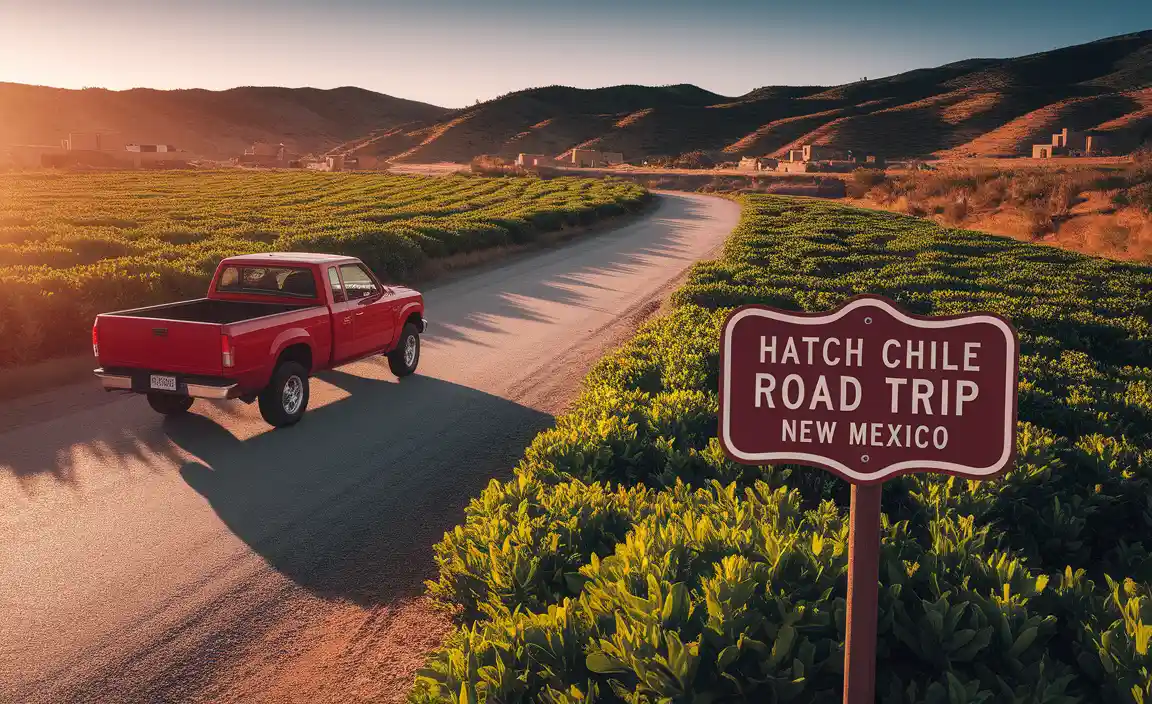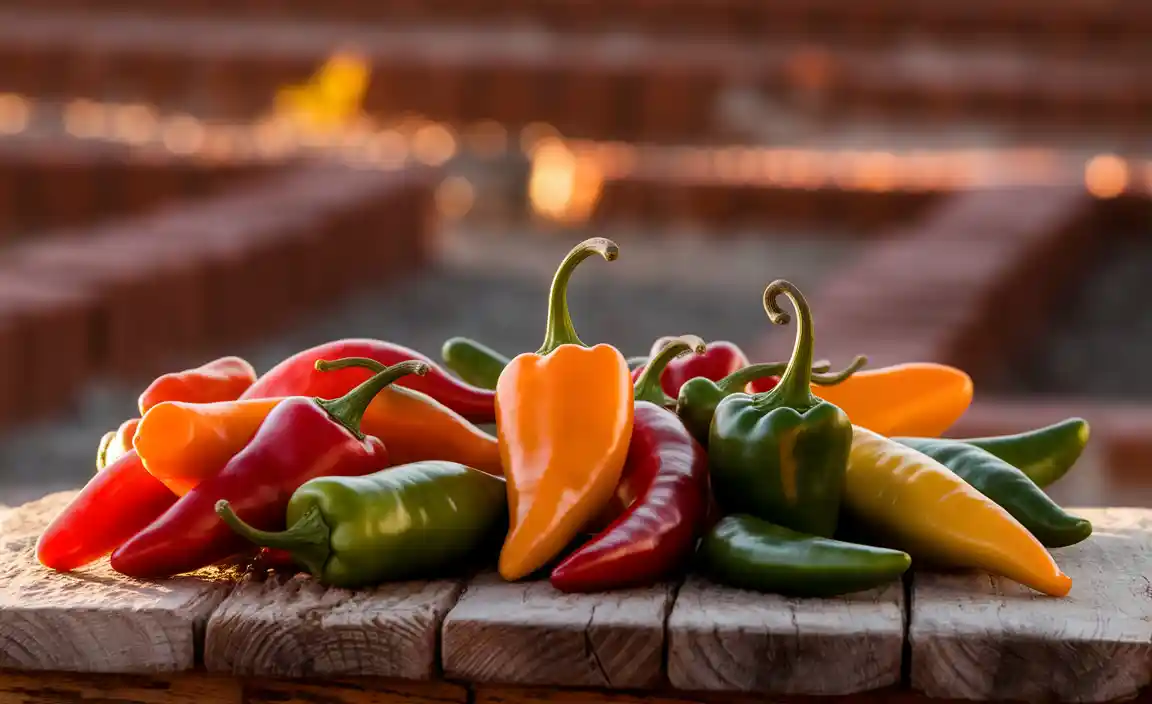Plan your Hatch Chile road trip in New Mexico for the ultimate fresh chile experience. Discover the best timing, towns, festivals, and how to get your hands on these iconic peppers from farm to fire.
New Mexico is the undisputed home of flavor, and during late summer and early fall, that flavor gets a zesty, smoky kick! If you’ve ever craved the perfectly roasted, uniquely spicy Hatch chile, then a road trip to its homeland is calling your name. But where do you start? Navigating the “Chile Capital of the World” can seem a tad overwhelming, especially if it’s your first time. Don’t worry, we’re here to guide you step-by-step, ensuring you capture the essence of this incredible culinary journey. Get ready for an adventure that will tantalize your taste buds and fill your car with the irresistible aroma of roasted green chiles!
I’m Joseph Bryant, and I believe that great food should be an adventure easily accessible to everyone. Whether you’re a seasoned home cook or just starting, this guide is designed to make your Hatch chile quest simple, fun, and incredibly delicious. We’ll cover all the essentials to make your trip unforgettable.

Your Hatch Chile Road Trip New Mexico: The Ultimate Beginner’s Guide

Ah, Hatch chile season! It’s not just a time of year; it’s a full-blown cultural event in New Mexico. These beloved peppers, grown primarily in the Hatch Valley, boast a unique flavor profile – a perfect balance of heat and sweetness, with a smoky undertone that intensifies when roasted. For anyone who loves a bit of zest in their life, this is your pilgrimage.
What Makes Hatch Chiles So Special?
It’s all about the terroir – the unique combination of soil, climate, and growing practices in the Hatch Valley. The slight salinity in the soil, the intense New Mexico sunshine, and the cool nights all contribute to the chile’s distinctive taste. This isn’t just any pepper; it’s a New Mexico treasure.
When is the Best Time for a Hatch Chile Road Trip?
The prime season for fresh Hatch chiles runs from August through September, with the peak harvest typically falling in late August and early to mid-September. This is when the chiles are at their freshest, most flavorful, and most readily available. Many of the festivals and roasting events also take place during this window.
What to Expect on Your Road Trip:
The Aroma: Prepare for your senses to be awakened. Roasting Hatch chiles creates an intoxicating, smoky aroma that will fill the air, especially in towns around the Hatch Valley.
Farm-Fresh Goodness: You’ll have the opportunity to buy chiles directly from farmers or at local markets, often still warm from the roaster.
New Mexico Culture: This trip isn’t just about peppers; it’s about immersing yourself in the rich culture, history, and culinary traditions of New Mexico.
Delicious Discoveries: Beyond the chiles themselves, you’ll encounter incredible New Mexican cuisine throughout your journey.
Planning Your New Mexico Chile Adventure: Where to Go

While the Hatch Valley is the heart of it all, several towns and regions offer fantastic experiences for chile enthusiasts.
The Hatch Valley: The Heart of the Chile Universe
This is your primary destination. The town of Hatch, New Mexico, proudly calls itself the “Chile Capital of the World.”
Hatch, New Mexico: The epicenter. Here, you’ll find countless farms, roadside stands, and markets selling fresh and roasted chiles. The local restaurants will undoubtedly feature them heavily on their menus.
Las Cruces: Located a short drive north of Hatch, Las Cruces is a larger city that also celebrates the chile season. You’ll find ample lodging, dining, and shopping options, with many vendors bringing their fresh chiles from Hatch into the city. It’s a great base if you prefer a city atmosphere.
Deming: West of Hatch, Deming is another charming town where you can find local chile vendors and experience the regional harvest festivities.
Beyond the Valley: Albuquerque and Santa Fe
While not in the direct Hatch Valley, these larger cities become hubs for chile lovers during the season.
Albuquerque: As New Mexico’s largest city, Albuquerque hosts numerous chile roasts and festivals throughout August and September. Many grocery stores and farmers’ markets will have large roasters set up, and you can buy bushels of fresh chiles to take home. It’s a convenient stop with plenty of amenities.
Santa Fe: Known for its vibrant arts scene and unique culinary landscape, Santa Fe also embraces the chile season. You’ll find restaurants featuring special chile dishes, and local markets will stock fresh chiles. Santa Fe offers a more upscale cultural experience alongside your chile quest.
The Hatch Chile Season: What to Know
The entire experience revolves around the harvest. Timing is crucial!
Key Dates and Events:
August: This is when the magic begins! Young green chiles start to appear, and the first major festivals often kick off. This is the start of the roasting season.
Early to Mid-September: This is generally considered the absolute peak. The chiles are abundant, and the flavor is at its best. Many of the most significant town festivals occur during this time.
Late September to Early October: The season winds down. You might still find fresh chiles, but availability can decrease. However, this can be a good time for “drying” chiles if that’s your intention.
##### Sample Festival Schedule (Dates vary annually, always check local listings):
| Town/City | Typical Festival Dates | Key Attractions |
| :————— | :—————————————– | :———————————————— |
| Hatch, NM | Late September | Chile roasting, food vendors, music, parades |
| Las Cruces, NM | Early to Mid-September | Chile markets, cooking contests, local produce |
| Albuquerque, NM | Various weekends throughout Aug/Sept | Grocery store roasts, farmers’ markets, events |
| Santa Fe, NM | Various weekends throughout Aug/Sept | Farmers’ markets, restaurant specials, artisan fairs |
Types of Hatch Chiles:

While all are delicious, there are varying levels of heat and flavor. Hatch chiles are typically classified from mild to hot.
Mild: Sweet and flavorful, with very little heat. Great for those who want the taste without the spice.
Medium: A good balance of heat and flavor, the most popular choice for many.
Hot: For those who crave a significant kick with that signature Hatch flavor.
You can often find them labeled by their heat level at markets and farms. Don’t be afraid to ask vendors for recommendations!
Your Chile Roasting Experience: From Field to Fire
The smell of roasting Hatch chiles is unmistakable and a highlight of any trip.
How Roasting Works:
Large, rotating drum roasters are used to tumble the chiles. The intense heat from propane flames (or sometimes wood fire) quickly chars the skin of the peppers, making them tender and imparting a smoky flavor.
Where to Get Them Roasted:
Roadside Stands: All through the Hatch Valley and in many towns across New Mexico, you’ll see vendors with large roasters set up. This is the classic experience!
Farmers’ Markets: Many larger farmers’ markets in cities like Albuquerque and Santa Fe will have professional roasters.
Grocery Stores: Major grocery chains in New Mexico often have roasters going during peak season.
##### Tips for Buying Roasted Chiles:
Buy them Fresh: It’s best to buy them as soon as they’re roasted.
Ask About the Roast: A good roast means the skin is blackened and blistered, but the chile inside is still firm.
Specify Your Needs: Let the roaster know the quantity you want (e.g., by the pound or bushel). A bushel is a lot – think 25-30 pounds!
Bring Your Own Bags: Some vendors might charge for bags, or you might prefer your own sturdy ones.
Roasting at Home:
While buying them roasted is convenient, you can also try it yourself! It’s rewarding and fills your home with that amazing aroma.
Tools for Home Roasting:
Gas Grill or Open Flame: The easiest method for a smoky flavor.
Broiler: Works in your oven, though it won’t have the same smoky depth.
Cast-Iron Skillet: Can work for smaller batches, requires attention.
How to Roast at Home (using a grill/open flame):
1. Preheat: Get your grill to medium-high heat.
2. Toss Chiles: Place chiles directly on the grill grates. Don’t overcrowd.
3. Tumble and Turn: Use tongs to turn the chiles frequently. They’ll blister and char on all sides.
4. Steam: Once charred, immediately place the hot chiles into a bowl and cover tightly with plastic wrap or a lid. Let them steam for 10-15 minutes. This loosens the skins.
5. Peel: Once cool enough to handle, rub off the blackened skins. Some black bits are fine and add flavor!
6. Seed and Stem: Cut off the stem and slice the chile open. Remove seeds and membranes if you prefer less heat.
For more detailed instructions on home roasting, you can check out resources from New Mexico State University’s chile programs, which are excellent for agricultural insights: New Mexico State University Extension Plant Sciences.
Packing Your Chiles: Taking the Flavor Home
So you’ve bought bushels of delicious, fresh Hatch chiles. How do you get them home safely and keep them fresh?
Short-Term Transport (1-3 days):
Cooler: The best option. Pack your roasted chiles (cooled down first) into airtight containers or freezer bags and place them in a cooler with ice packs. Keep them out of direct sunlight.
Paper Bags: If you plan to use them within a day or two and won’t be in extreme heat, sturdy paper bags can work, but they offer less protection.
Long-Term Storage:
Freezing: This is the most popular and effective method.
1. Roast and Peel: Ensure your chiles are roasted, peeled, and seeded (if desired).
2. Portion: Decide how you’ll use them. You can freeze them whole, chopped, or even pureed into a paste.
3. Package: Use heavy-duty freezer bags or airtight containers. Remove as much air as possible to prevent freezer burn.
4. Label: Date and label your bags/containers.
Tip: Many people freeze them in 1-lb or 2-lb portions, which is convenient for common recipes.
Drying: If you get chiles towards the end of the season, you can dry them to make chile powder or ristras. This often involves air-drying them in a warm, dry place or using a dehydrator.
Iconic New Mexico Dishes Featuring Hatch Chiles
Your road trip is a fantastic opportunity not only to buy chiles but to taste them in their native dishes.
Must-Try Dishes:
Green Chile Stew: A hearty, comforting stew made with pork or sometimes chicken, potatoes, onions, and of course, plenty of chopped green chiles.
Red or Green? In New Mexico, it’s a common question at restaurants: “Red or Green?” When ordering, you can ask for “Christmas” if you want both. Many dishes can be topped with either a rich red chile sauce or a bright green chile sauce.
Chile Cheeseburger: A classic New Mexico burger topped with a generous spoonful of roasted green chiles. Often found at diners and burger joints.
Tamales: Steamed masa dough filled with savory fillings, often including green chile.
Enchiladas: Corn tortillas layered with cheese, meat or vegetables, and smothered in red or green chile sauce.
Frito Pie: A beloved dish typically served in a bag of Fritos, layered with beans, meat, cheese, and topped with red or green chile.
Sopapillas: Light, airy fried dough pastries. They can be served sweet with honey, or savory topped with green or red chile.
Your Hatch Chile Road Trip Itinerary: A Sample Plan
This is a flexible outline; adjust it based on your interests and available time!
Duration: 3-5 Days
Day 1: Arrival in Albuquerque & Chile Immersion
Arrive in Albuquerque. Check into your hotel.
Visit a local grocery store (like Smith’s or Albertsons) or a large farmers’ market known for its chile displays and roasters. Buy your first batch of fresh, roasted chiles.
Enjoy dinner at a well-regarded New Mexican restaurant, ordering dishes with green chile (“Red or Green?”).
Optional: Visit the Hispanic Heritage Planning Committee website for event schedules if traveling near September.
Day 2: Hatch Valley Exploration
Drive south towards Hatch (approx. 2-hour drive from ABQ).
Explore the town of Hatch: visit local markets and farms. Buy more chiles! Witness the vast quantity of chiles being harvested and prepared.
Talk to the farmers and vendors – they are often passionate about their produce.
Have lunch in Hatch. Try a chile cheeseburger or green chile stew.
Consider a short drive to nearby towns like Radium Springs for more local flavor.
Return to Las Cruces for the night (approx. 45 mins from Hatch), a city with more lodging and dining options.
Day 3: Las Cruces Culture & Return North
Explore downtown Las Cruces. If any local festivals are happening, attend them.
Visit the New Mexico State University Grants website for potential research or exhibits related to agriculture in the region. (Note: While this link might not directly be about chiles, it points to a reputable educational institution in the area relevant to agriculture and local history).
Enjoy a final New Mexican breakfast or lunch.
Begin your drive back north, perhaps stopping in Truth or Consequences for a unique detour, or head directly back to Albuquerque or your next destination.
Day 4-5 (Optional): Santa Fe Detour
If time permits, drive north to Santa Fe (approx. 4.5 hours from Las Cruces, or 1 hour from ABQ).
Explore Santa Fe’s Plaza, visit art galleries, and enjoy its unique ambiance.
Seek out farmers’ markets for fresh chiles.
Dine at some of Santa Fe’s renowned restaurants.
Depart from Santa Fe or return to Albuquerque for your flight.
FAQ: Your Hatch Chile Road Trip Questions Answered
Q1: What are Hatch chiles, and why are they famous?
A: Hatch chiles are a specific variety of pepper grown primarily in the Hatch Valley of New Mexico. They are famous for their unique, mild to medium heat with a naturally sweet and slightly smoky flavor, attributed to the valley’s special soil and climate.
Q2: When is the best time to visit New Mexico for Hatch chiles?
A: The prime season for fresh Hatch chiles is from August through September, with the peak harvest typically in late August and early September. This is also when most related festivals occur.
Q3: How many chiles should I buy? Is a bushel a lot?
A: A bushel of chiles is a significant amount, usually around 25-30 pounds. For most home cooks, a few pounds or a half-bushel is more manageable. Consider how much you can realistically store and use before buying too many.
Q4: How do I transport fresh Hatch chiles home?
A: For short trips (1-3 days), pack roasted, cooled chiles in airtight containers or bags in a cooler. For longer storage, freezing is the best method.
Q5: What’s the difference between buying fresh and roasted chiles?
A: Fresh chiles are raw and need to be prepared (roasted, cooked) by you. Roasted chiles have been charred over heat, have their skins removed, and are ready to use in recipes or to be frozen for later. The roasting process also adds a delicious smoky flavor.
Q6: Are there different heat levels of Hatch chiles?
A: Yes, Hatch chiles come in various heat levels, typically categorized as mild, medium, hot, and extra-hot. You can usually ask vendors for guidance based on your spice preference.
Q7: What are some easy New Mexico dishes to make with Hatch chiles?
A: Excellent beginner-friendly dishes include green chile stew, chile cheeseburgers, enchiladas, or simply roasted chiles served as a side dish. They’re also great added to eggs, soups, and casseroles.
Beyond the Roadside Stand: More Flavorful Adventures
Your Hatch chile road trip is more than just a pepper pilgrimage; it’s a deep dive into the soul of New Mexican cuisine. From the moment you pick up your first chile to the last spicy bite of a traditional dish, you’re experiencing a vital part of the state’s culture and heritage.
Embrace the heat, savor the unique flavor, and don’t be afraid to ask locals for their favorite chile recipes or hidden gem eateries. The people you meet, the stories you hear, and the incredible food will make this trip an unforgettable culinary adventure. Happy travels, and may your chiles be perfectly roasted!